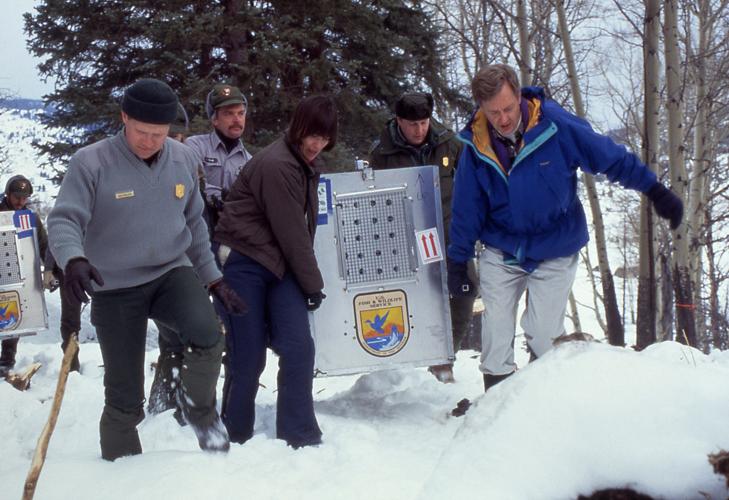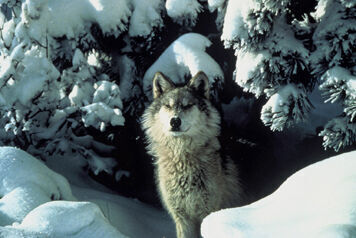INSIGHTS | Proponents say wolves are lambs in wolves’ clothing
Of all the problems in the world right now, can anybody say a wolf at Colorado’s door is at the top of the list?
This November Coloradans will decide a simple question on a complicated issue. Things have changed quite a lot since they were hunted into extinction in Colorado, like most places, 80 years ago.
While proponents contend the question should be scientific and not political, two of the state’s best-known Democrats are the faces of the movement: former Gov. Bill Ritter and former U.S. Sen. Mark Udall.
The Udalls for generations have been the first family of conservation in this West, since Mark’s uncle Stewart Udall was the secretary of the interior under presidents Kennedy and Johnson. Mark Udall served on the Senate Natural Resources Committee.
Wolves might present micro problems, he concedes, but they bring macro solutions as a much-needed apex predator.
They thin elk and deer herds, or, more importantly, force them to take cover away from the rivers and streams that are vital to the West. Left unimpeded, deer and elk munch vegetation to the nub, creating erosion and other dire impacts to fish, insects and birds that rattle through the ecosystem. Overpopulated deer tend to be sick deer who wander onto roads and into civilization, leaving their unhealthiness in the gene pool.
“For me, it makes eminently good sense from a conservation point of view and from an ecosystem point of view,” Udall said in a phone chat I had with him and Ritter.
Ritter grew up on a wheat farm east of Aurora. It’s ranchers who are most concerned, he understands, but livestock mortality due to wolves hasn’t proven out in other states.
“There have been wolf reintroductions in other states, and I would consider those successful,” Ritter said, who has been following the potential for Colorado wolves since he was governor more than a decade ago. “They have not been without problems and issues that involve the intersections wolves have with the rest of the ecosystem, but on the whole I’m very much in agreement with what Sen. Udall says: they are an apex predator and there’s a lot of science around the benefits to the ecosystem.”
A state dominated by Front Range voters will decide whether to introduce wolves on the Western Slope and have taxpayers cover the tab for dead livestock. There are a lot more people now than there were when wolves were hunted out of existence in Colorado 80 years ago. In November it will bear watching to see how the Western Slope votes.
In January a group of natural resources “investigators” at Colorado State University released a report on public views on wolf reintroduction and management.
The report included a statewide online survey of 734 Coloradans in August of last year. Online surveys aren’t always representative of the population and have their fair share of skeptics, but the margins were still remarkable.
The CSU researchers projected as much as 84.9% of Front Range residents, 79.8% of Western Slope residents and 79.3% on the Eastern Plains supported wolf reintroduction.
Opponents, led by the Farm Bureau, contend nature provides … or it doesn’t: If wolves wanted to be back in Colorado, they’d already be here. In fact, they’re occasionally spotted.
An occasional wolf is not a populated wilderness, or even a sustainable pack, said Rob Edward, president of the Rocky Mountain Wolf Action Fund.
“The bottom line is the wolves are secure in Yellowstone, and you’ll continue to have a few that will survive that perilous journey southward to northwest Colorado from time to time,” he said. “But it is such a perilous journey it’s not ever going to result in Colorado getting colonized naturally. It’s just not going to happen.”
There’s no guarantee relocated wolves provided by Colorado taxpayers won’t wind up in gunsights, on SUV grills or in a state that doesn’t want them.
A gray wolf can roam 30 miles in a day, and a pack can hunt in a territory of 50 square miles to 1,000 square miles, depending on the food supply. It won’t take long to encounter a hiker or a Subaru.
Republican lawmakers on Colorado’s western border don’t want the overflow. Last spring the Utah legislature passed a Republican-led resolution that was signed by the governor to oppose reintroduction and throw shade at Colorado.
“There is not a current attempt to force wolves into Utah, however a 2020 Colorado ballot measure seeks to forcibly place wolves into the western part of the state, not far from the Utah-Colorado border,” the resolution states. “If that effort is successful, history shows that wolves will multiply and spread. The mid-1990s central Idaho release of 35 wolves since spread statewide (1,500 last summer), Montana, (900 wolves), Washington (126 wolves), Oregon (137) and are as far as 600 miles away in northern California.”
While that paints a concerning picture, Edward contends it’s not an accurate one. Look to Lake Erie, where the wolves are flush in proximity to thousands of Minnesotans and various hot dishes.
“We can’t concern ourselves too much with what’s going on in other governmental jurisdictions — Utah, Wyoming, New Mexico,” he said. “We’d love to show those states what it means to be a modern, progressive, environmentally conscience culture.”






